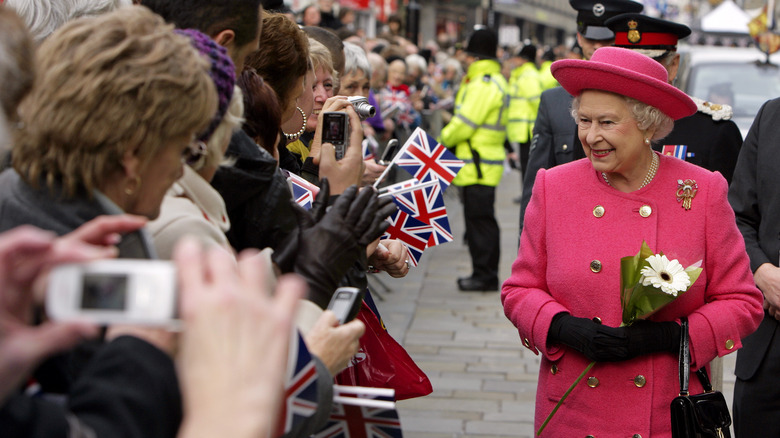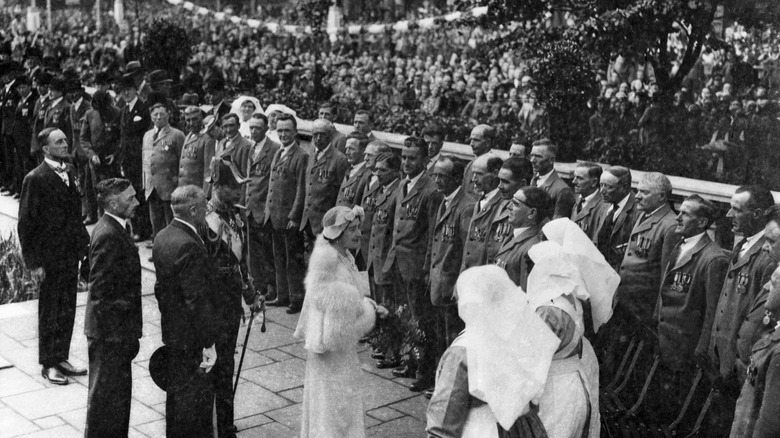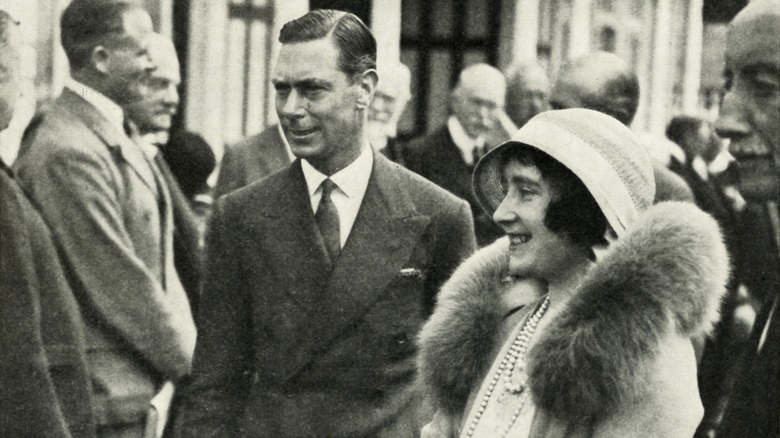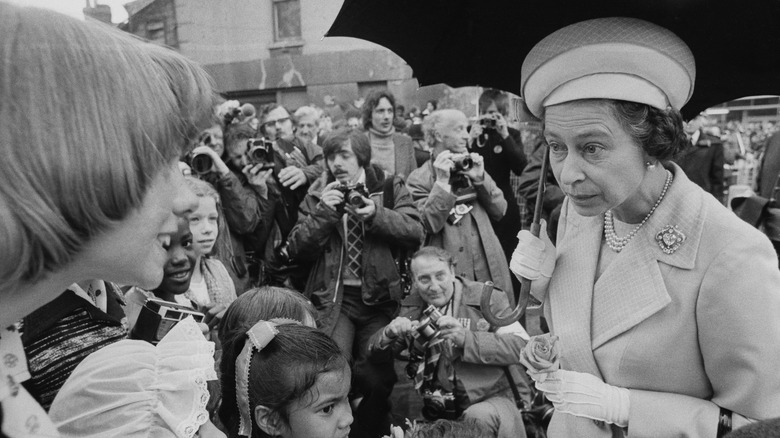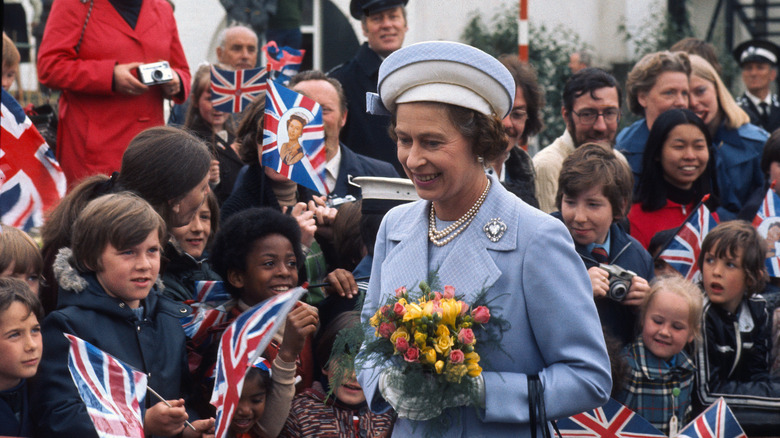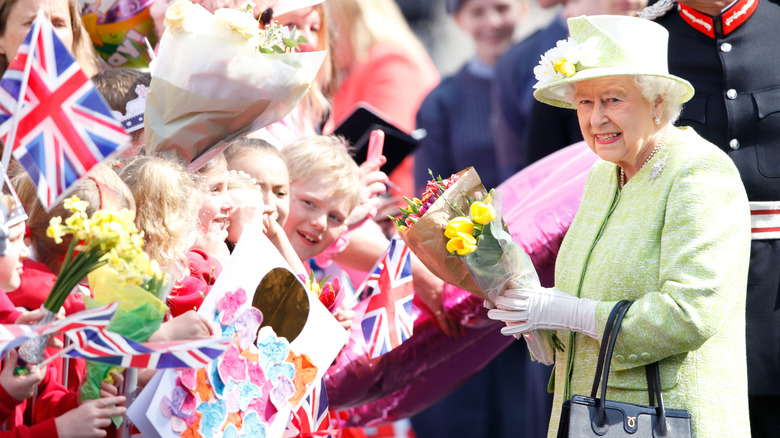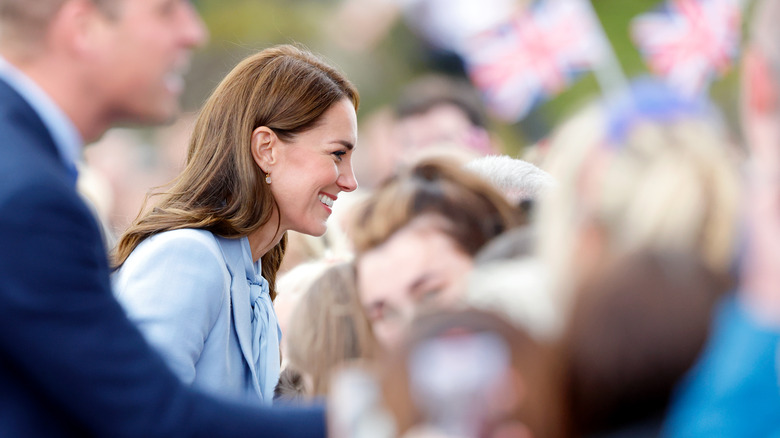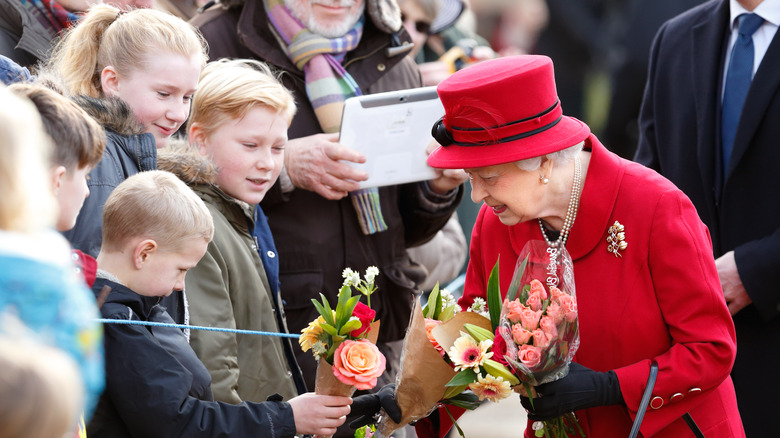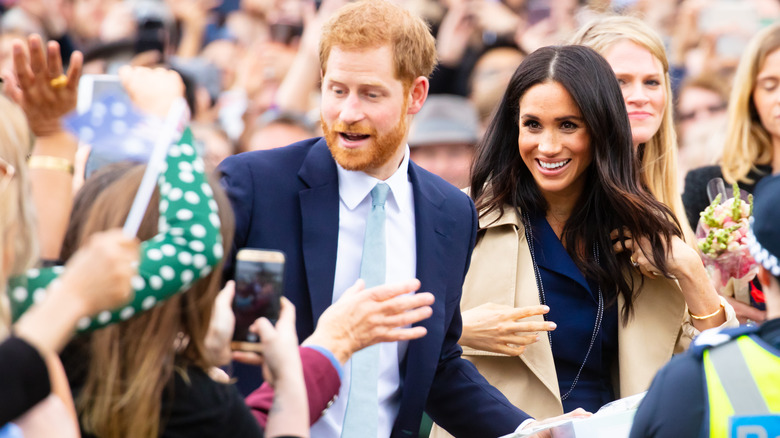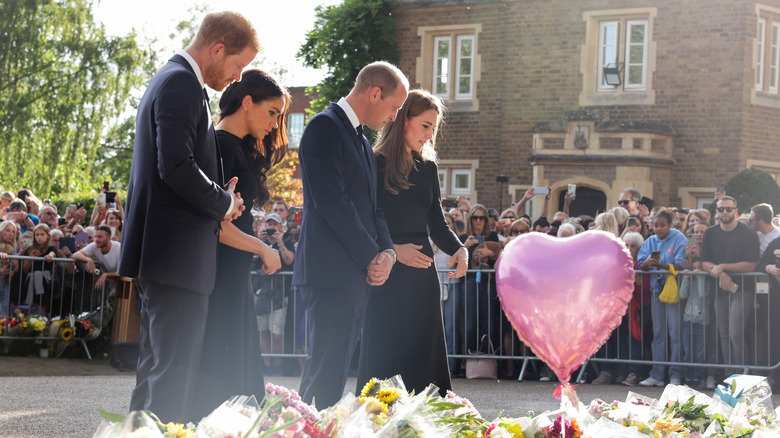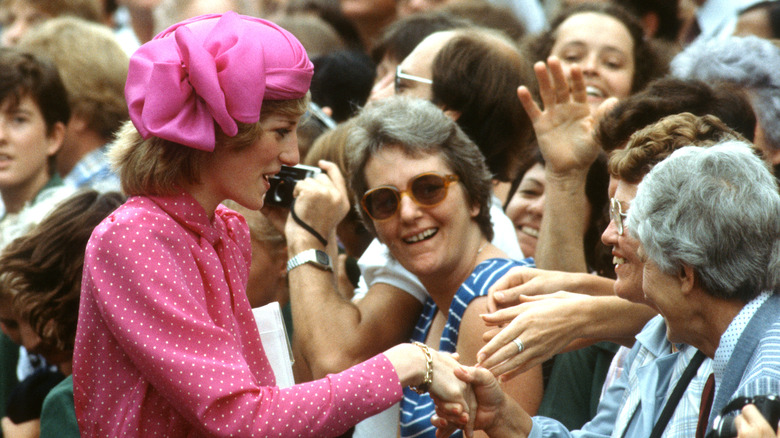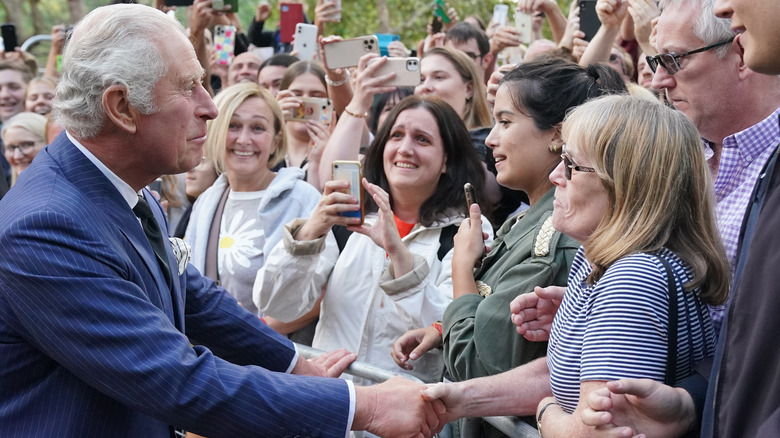Royal Walkabouts: Here Are All The Details About The Famous Tradition
When Queen Elizabeth II died after 70 years on the throne, the royal family was thrown into a period of instant change. Charles, who has been heir for most of his life, immediately became King Charles III, and he handed down a series of titles that designated his family members in new ways. The newly minted Prince and Princess of Wales — William and Catherine — are by far the most popular royals, and some may have even preferred to see William take over the throne, circumventing Charles from ever ruling. Despite public opinion, Charles did ascend, and a series of events engaging with royal mourners took place. Amid the sadness rippling through the country were designated royal walkabouts, which allowed the new king, queen consort, and royal family members to grieve alongside the public.
Perhaps the most famous walkabout to occur in the week after Elizabeth's death took place outside Windsor, where William and Catherine were joined by Prince Harry and Meghan Markle. It was a sight that many did not see coming, and yet the unified front allowed the public to see that even in the face of conflict, the brothers put aside their differences for the common good. While this may be the most recent walkabout to garner such attention, the practice has been around for decades. Here are all the details you need to know about the royal tradition.
The walkabout began as a response to World War II
When Europe — and the world at large — was ravaged by the damages of World War II, morale was at an all-time low. In an attempt to boost the public confidence and attitudes surrounding the war effort, King George VI and Queen Elizabeth, the Queen Mother, visited Commonwealth countries to visit with the public. As noted by the Royal Collection Trust (RCT), the king and queen were joined by the Canadian prime minister during their stop in the Commonwealth country of Canada, and visited with soldiers, scouts, and members of the public amid their visit. In order to bridge the gap between themselves and the public, Elizabeth simply started engaging with the soldiers who had come to see them — and the walkabout was born.
"The area was very crowded," Harold Blackman, a former soldier, told The Globe and Mail of the famous interaction with the royals. "And being a young soldier, I paid attention to what I had to do." Of the queen, John Aimers, head of the Monarchist League of Canada, further told the publication, "She just plunged through that Ottawa crowd, and it just wasn't done in those days."
The queen later reflected on the walkabout and the visit to Canada as a whole, admitting, "I lost my heart to Canada and to Canadians, and my feelings have not changed with the passage of time."
Walkabouts allowed for royal accessibility, known as the 'royal common touch'
Some of us may not be overly familiar with the Queen Mother, as she passed away in 2002, but she was a superstar of the royal family during her day. When she launched the royal walkabout all those years ago in Canada, she repeated the practice after the Blitz, The Globe and Mail noted, and continued to connect with the public during times of tragedy.
General Roger Rowley, who was carrying the flag of his regiment during a royal walkabout, later interacted with the royals during a garden party in Ottawa, Canada. He recalled of the Queen Mother, "She was gracious. She told me it was a great show we had put on." Further reflecting on the interaction, the retired general admitted, "it didn't strike me as important then as it does now. I wish it had. But I'm older now and a little bit wiser" (via The Globe and Mail).
As the walkabout continued to evolve with time, the Queen Mother became synonymous with the "royal common touch," the Los Angeles Times noted in her obituary. Her ability to connect with the public in such an informal way arguably set the tone for the latter half of the 20th century.
Queen Elizabeth took the walkabout to the next level in the 1970s
When Queen Elizabeth II hit the royal scene, she was merely a princess who was not in line for the throne in any life-altering capacity. But when her uncle abdicated, and then her father took the throne and later passed, it was her turn to take on the role. Though her mother started the walkabout tradition, many members of the public got glimpses of the royal family as they were driven through the streets in cars, Harper's Bazaar notes — there was little public interaction, and even Princess Anne reflected on the royal rules when greeting fans.
"We never shook hands. The theory was, you couldn't shake hands with everybody, so don't start," the princess explained. However, as shown in a documentary about the late queen, the monarch significantly changed the game in the "flower power" era.
"In the 1970s, the queen decided to shake things up. She wanted to say hello to the crowds — and the walkabout was born," the documentary entitled "Queen of the World" asserted. Debuting the walkabout in Australia and New Zealand, the queen's new way of interacting with the public allowed her "to meet a greater number of people, not just officials and dignitaries." By doing so, as History notes, the queen "bucked centuries of royal tradition" in a single stroll.
The late queen made walkabouts part of her jubilee celebrations
Queen Elizabeth II is remembered for a variety of things: Her dedication to the crown superseded every other member of the royal family, and her commitment to remaining politically neutral enabled many members of the Commonwealth to identify with her. But, of course, she'll go down in history as the longest-serving monarch in British history, and her jubilee celebrations were often accompanied by pomp and circumstance as well as public interaction.
As detailed by History, Elizabeth and her late husband, Prince Philip, arrived at St. Paul's Cathedral via the Gold State Coach for her 25th jubilee celebration, where the queen greeted members of the public outside the storied church. Marking her 25th year on the throne, the queen uttered the same words she said when her reign began: "Although that vow was made in my salad days when I was green in judgment, I do not regret nor retract one word of it."
About 25 years later, the queen was at it again, celebrating half a century on the throne. It was not only a time of jubilee, but also of personal loss, as the queen had suffered the deaths of both her mother and sister in 2002. But, just as she did all those years prior, Elizabeth marked her 50th jubilee with members of the public, traveling 40,000 miles across the Commonwealth throughout the year. She visited 70 cities and 50 counties, while taking part in the now-famous walkabout.
Queen Elizabeth's 90th birthday marked one of her biggest walkabouts in history
As Queen Elizabeth started getting up in years, those around her took measures to make sure that her health and well-being were strictly monitored. She became synonymous not only with the throne, but with Great Britain itself, and members of the public under the age of 70 had never known anyone else as a monarch — simply put, she was a staple of British life.
In 2016, the beloved queen turned 90 years old, and as such, the country and Commonwealth as a whole threw quite a party. As noted on the official royal website, the streets were lined with well-wishers who came out to celebrate the big day — and, of course, the queen partook in a number of walkabouts amid the festivities.
Some of the highlights of Elizabeth's 90th birthday were detailed by the royal family's Twitter account at the time. Not only were "the streets of Windsor packed with members of the public," but beloved dogs — corgis in particular — joined their owners to wish the queen a happy birthday. The monarch was met with a number of "Happy Birthday" tunes while engaging in walkabouts, and was even presented with a cake made by Nadiya Hussain, the winner of "The Great British Bake Off" in 2015. Simply put, the queen's 90th birthday was a can't-miss celebration.
Kate Middleton was teased by the family about her approach to walkabouts
While some would argue that Prince Harry married for love, others would say that Prince William married for duty. Sure, there seems to be quite a lot of love between the Prince of Wales and Catherine, Princess of Wales, but she is arguably the royal family's secret weapon when it comes to good public relations, a dignified front, and a great example of the crown. Simply put, Catherine knows how to be a royal and how to play the game extremely well.
While she is certainly the publicly approved face of the monarchy, Catherine admitted during a documentary made honoring the queen that the royal family made fun of her due to her approach to walkabouts, as detailed by Vanity Fair. Regarding members of the firm poking fun at her, the Princess of Wales said that while it was all in good fun, she takes the walkabout very seriously.
"There's a real art to walkabouts; everybody teases me in the family that I spend far too long chatting," Catherine said on camera. "I still have to learn a little bit more, and to pick up a few more tips, I suppose." Telling the cameras that Queen Elizabeth offered to help take her through the walkabout steps, Catherine later said, "She's been generous and not forceful at all in her views, and she's really been there in a gentle guidance for me."
Queen Elizabeth was reportedly 'fed up' with walkabouts toward the end of her life
As Queen Elizabeth II continued to rule Great Britain, the world around her drastically changed. Over seven decades, the queen witnessed quite a bit of progress in technology and communication. While some would argue that smartphones, social media, and consistent documentation of the world are positive things, the queen was said to have gotten a bit "fed up" with walkabouts — and the public in general — due to a camera phone always being in her face.
Royal author Ian Lloyd, who wrote "The Queen: 70 Chapters in the Life of Elizabeth II," told Express that the practice of walkabouts had changed drastically from when the queen first introduced them in the 1970s.
"[Walkabouts] were set up by her in the 1970s as a way of meeting people, but these days people only want selfies and photographs of her, they just hold up their cameras or, even more alarming, their iPads, so she is faced with a wall of that when she looks at the crowd, it's horrible," Lloyd asserted. "Princess Anne once said that, because of their phones, people now only actually believe they have seen something if they can photograph it, so they lose the immediacy, their memory."
"Also, there is a lack of respect in this," Lloyd further detailed. "When the walkabout started 40 or 50 years ago, people would have never dreamed of sticking up a camera in the queen's face."
Meghan Markle focused on the walkabout during her Netflix docuseries
Love them or hate them, Prince Harry and Meghan Markle made walkabouts an integral part of their short-lived roles as joint senior royals. Early in her engagement to Harry, all eyes were on Meghan when she did her inaugural walkabout, as it was the first of a series of tests to see how she would adjust to royal life. But, as part of the new Netflix documentary entitled "Harry and Meghan," the Duchess of Sussex told the cameras that the walkabout wasn't nearly as simple as it appeared to be — in fact, she claimed she didn't even know what it was until she found herself participating in one in real time.
Saying that she didn't want to wave "like an American" or make a fool of herself in front of the public, Meghan admitted, "I never saw pictures or videos of a walkabout. Like, 'What's a walkabout?'" Following her admission was footage of her very first attempt at the public practice, and she was captured greeting well-wishers, shaking hands, and chatting with members of the public like a pro. And while she certainly made it through, Meghan admitted that the formalities of royal life were certainly jarring.
"Americans will understand this. We have Medieval Times, dinner and tournament. It was like that," she said.
William, Harry, Kate, and Meghan made an eye-catching walkabout after the queen died
Unless you've been living under a rock, you know that Prince William and Prince Harry have been feuding for years. Reportedly stemming from William's voiced concerns over the speed of Harry's relationship with Meghan Markle, the brothers have decided to walk two very different paths — William, as the direct heir to the throne, is very much embroiled in the royal way of life and tradition. Harry, on the other hand, is making it a point to highlight the institution's shortcomings, exposing centuries-old judgments, unnecessary tradition (in his perspective), and more — not to mention doing so all the way from California. To say that the brothers are doing things very differently is an understatement, and the two have rarely been seen together in recent years. That all changed, however, when the sons of Diana Spencer reunited in the aftermath of Queen Elizabeth II's passing, partaking in a walkabout that grabbed everyone's attention.
As noted by Reuters at the time, William, Harry, Catherine, Princess of Wales, and Meghan, Duchess of Sussex, all came together for a walkabout outside Windsor following the queen's death. As the four greeted mourners, engaged in conversation, and placed flowers in the queen's memory, the walkabout garnered so much attention given its rather historic undertaking — it certainly was not expected that the brothers would reunite in such a public display of collective mourning.
Diana Spencer defined the walkabout in her own special way
Before we get to the walkabout as it stands today, we must look back at the practice when it was undertaken by Diana Spencer, the late Princess of Wales. Diana, just a teenager at the time of her engagement to then-Prince Charles of Wales, became a dynamite member of the royal family, known for doing things her way. In many ways, Prince Harry is following in her rule-breaking footsteps.
While the walkabout is certainly a more informal way for the royal family to interact with members of the public, there is still a formal approach to the practice — many royal family members choose to wear gloves when shaking hands and greeting fans, reportedly to avoid the passing of germs or any kind of cold or flu bug. But, in Diana's perspective, gloves were yet another barrier between herself and members of the public, so she greeted people bare-handed.
"[Diana wanted to] convey approachability and warmth," Eleri Lynn, the curator of the Diana Spencer exhibit at Kensington Palace, told People. "She abandoned the royal protocol of wearing gloves because she liked to hold hands when visiting people or shake hands and have direct contact. She also stopped wearing hats because she said, 'You can't cuddle a child in a hat.'"
Mourners rallied around King Charles III amid the walkabout after the queen died
Now to the royal walkabout as it stands today. The COVID-19 pandemic had stopped members of the royal family from interacting with the public in such a close-contact capacity for quite some time, but as the pandemic's veracity continues to decrease with time, the royals are back at it again with the walkabout. Members of the public flooded the streets in the wake of Queen Elizabeth II's passing, and though he was clearly mourning his mother, King Charles III took the time to interact with those grieving.
As noted by The Telegraph, Charles and Camilla, the queen consort, partook in a walkabout while traveling from their residence of Clarence House to Buckingham Palace. Greeting mourners on Stable Yard, which is just off the Mall, Charles and Camilla shook hands, chatted with members of the public, received flowers, and generally made their presence known as the new reigning monarchs of Great Britain. Charles was met with a number of iterations of "God Save the King," the national anthem that was changed overnight from the decades-old "God Save the Queen," marking yet another colossal change thrust Charles' way. Though it was only the second day of mourning, the new king made it known that walkabouts would continue to be a practice throughout his reign.
